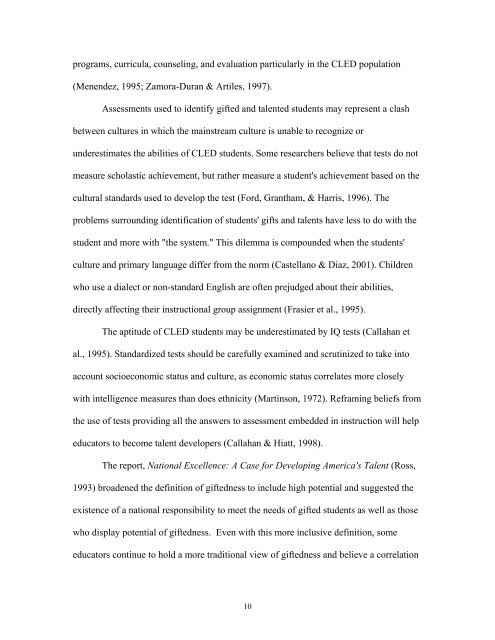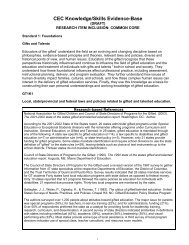Chapter One An Introduction to the Topic of Cultural Diversity - NAGC
Chapter One An Introduction to the Topic of Cultural Diversity - NAGC
Chapter One An Introduction to the Topic of Cultural Diversity - NAGC
You also want an ePaper? Increase the reach of your titles
YUMPU automatically turns print PDFs into web optimized ePapers that Google loves.
programs, curricula, counseling, and evaluation particularly in <strong>the</strong> CLED population<br />
(Menendez, 1995; Zamora-Duran & Artiles, 1997).<br />
Assessments used <strong>to</strong> identify gifted and talented students may represent a clash<br />
between cultures in which <strong>the</strong> mainstream culture is unable <strong>to</strong> recognize or<br />
underestimates <strong>the</strong> abilities <strong>of</strong> CLED students. Some researchers believe that tests do not<br />
measure scholastic achievement, but ra<strong>the</strong>r measure a student's achievement based on <strong>the</strong><br />
cultural standards used <strong>to</strong> develop <strong>the</strong> test (Ford, Grantham, & Harris, 1996). The<br />
problems surrounding identification <strong>of</strong> students' gifts and talents have less <strong>to</strong> do with <strong>the</strong><br />
student and more with "<strong>the</strong> system." This dilemma is compounded when <strong>the</strong> students'<br />
culture and primary language differ from <strong>the</strong> norm (Castellano & Diaz, 2001). Children<br />
who use a dialect or non-standard English are <strong>of</strong>ten prejudged about <strong>the</strong>ir abilities,<br />
directly affecting <strong>the</strong>ir instructional group assignment (Frasier et al., 1995).<br />
The aptitude <strong>of</strong> CLED students may be underestimated by IQ tests (Callahan et<br />
al., 1995). Standardized tests should be carefully examined and scrutinized <strong>to</strong> take in<strong>to</strong><br />
account socioeconomic status and culture, as economic status correlates more closely<br />
with intelligence measures than does ethnicity (Martinson, 1972). Reframing beliefs from<br />
<strong>the</strong> use <strong>of</strong> tests providing all <strong>the</strong> answers <strong>to</strong> assessment embedded in instruction will help<br />
educa<strong>to</strong>rs <strong>to</strong> become talent developers (Callahan & Hiatt, 1998).<br />
The report, National Excellence: A Case for Developing America's Talent (Ross,<br />
1993) broadened <strong>the</strong> definition <strong>of</strong> giftedness <strong>to</strong> include high potential and suggested <strong>the</strong><br />
existence <strong>of</strong> a national responsibility <strong>to</strong> meet <strong>the</strong> needs <strong>of</strong> gifted students as well as those<br />
who display potential <strong>of</strong> giftedness. Even with this more inclusive definition, some<br />
educa<strong>to</strong>rs continue <strong>to</strong> hold a more traditional view <strong>of</strong> giftedness and believe a correlation<br />
10

















